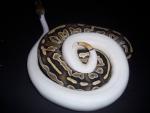» Site Navigation

1 members and 1,222 guests
Most users ever online was 47,180, 07-16-2025 at 05:30 PM.
» Today's Birthdays

» Stats

Members: 75,937
Threads: 249,130
Posts: 2,572,295
Top Poster: JLC (31,651)
|
-
Getting to know my water.
Well my water is FINALLY starting to trust me. Hes alittle over two feet at the moment. And he no longer hides when Im cleaning his water bowl at night. And he comes straight up to me to take food off tongs. Hes come a long way from the day I got him. He didnt want me to see him at all. I dont believe in handling monitors to try to tame them down in my experience that has done nothing but stressed the animal out even more. But I can not tell you how happy I am that he will come right up to me and take food off tongs and he doesent even run away and hide with to eat anymore he will eat right in front of me and that is A HUGE change. I think im on my way to having a monitor that tolerates my presence. Which will make a ton of difference when its a bit larger
-
-
BPnet Veteran


Re: Getting to know my water.
definatly! its not fun to have such an AWESOME animal and it hate you.
i mean who doesnt want a lizard dog!?!
-
-
Re: Getting to know my water.
Great news!
Yes, I feel the same way as far as handling. Here's my list of rules for establishing relationships with varanids:
1. NEVER smell like anything other than yourself. Most people know the obvious of never smelling like food, but I go one step further and never have cologne, hand cream, sanitizer or soap residue on my hands when working with them. Just rinse thoroughly with warm water and then that way they will smell you and nothing but you and the smell will always be the same.
2. Take things at THEIR pace. Don't force anything upon them. If they don't come close to you; don't push it. If you don't have patience, then don't get monitors. I have been working with an Ornate monitor since August of 08. He's 16 months old now and still does not like to be picked up. So I don't. Petting, stroking and feeding are non-eventful wonderful times of interaction, but as you can tell, there is still no picking up... yet.
3. Work with them in THEIR territory. As soon as you take a monitor, tame or not, and put it into an unfamiliar space, you are asking for trouble. With calm, established adults who have proved their trust in you ventures can start a little at a time, but until then work in the enclosure only. That's one of the reasons for the larger ones a walk-in is a mandatory requirement.
4. Establish "feeding cues", either a behavior or sound that let them know when it's feeding time. This way you are not getting charged with the expectation of food. My Ornate is fed at the same time every day and he is given the cue of "Treats". And he responds accordingly!
That's the main ones. There's probably more I can't think of off the top of my head
Chris
"That cute little lizard in the pet shop will, in a few short years, become an enormous, ferocious carnivore; capable of breaking the family cat's neck in a single snap and swallowing it whole." - Daniel Bennett
passion.herp
passionherp.com
info@passionherp.com
facebook.com/passion.herp
-
The Following User Says Thank You to mumps For This Useful Post:
-
Re: Getting to know my water.
When I feed mine I make a little noise sorta like calling a dog or cat to let him know im bringing him food. That seems to work good!
-
-
Registered User

Re: Getting to know my water.
Glad to here you monitor is coming around.Your definitely moving in the right direction.Keep up the good work and pretty soon you will have a giant eating machine on your hands
greg
-
 Posting Permissions
Posting Permissions
- You may not post new threads
- You may not post replies
- You may not post attachments
- You may not edit your posts
-
Forum Rules
|








 Reply With Quote
Reply With Quote